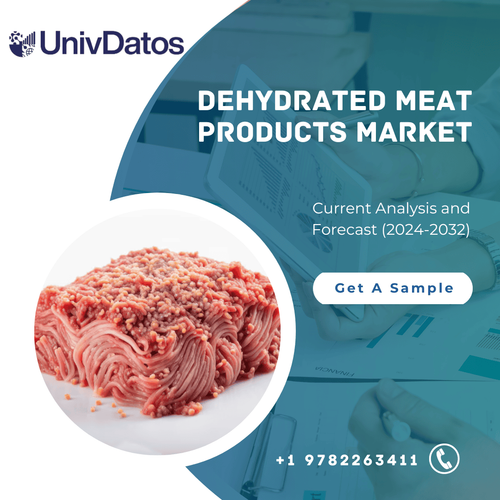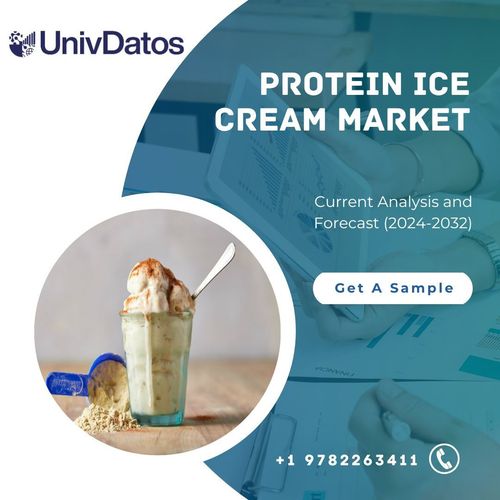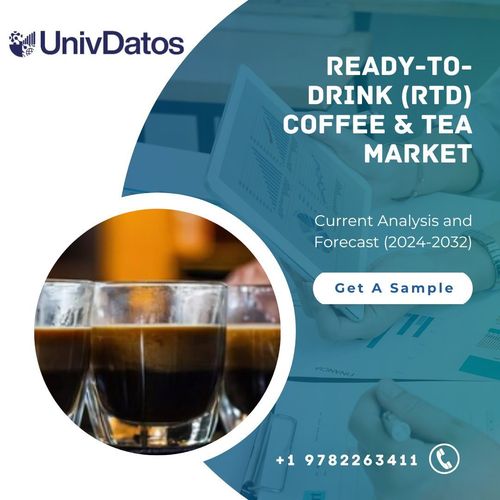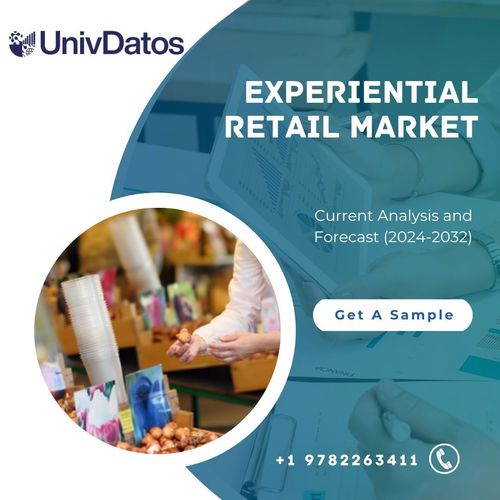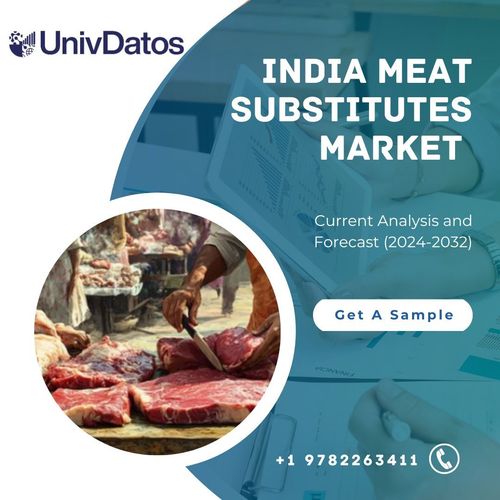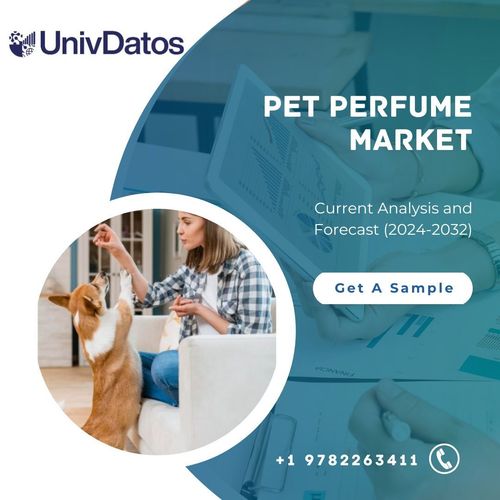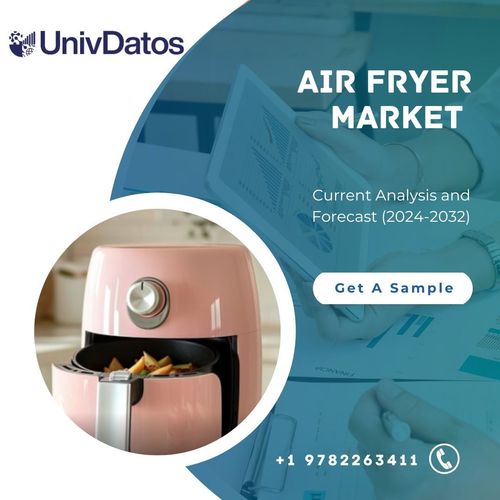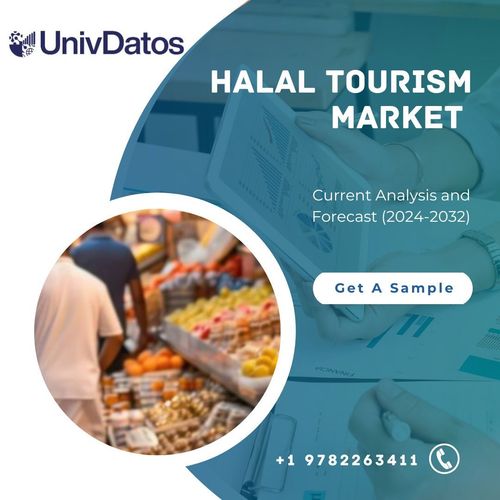Food Flavor Enhancer Market Current Analysis and Forecast (2021-2027)
Emphasis on Type (Acidulants, Glutamates, Hydrolyzed Vegetable Protein, Yeast Extracts, and Others), Source (Artificial and Natural), Form (Powder and Liquid), Application (Processed & Convenience Foods, Beverages, Meat & Fish Products Others), and Region and Country
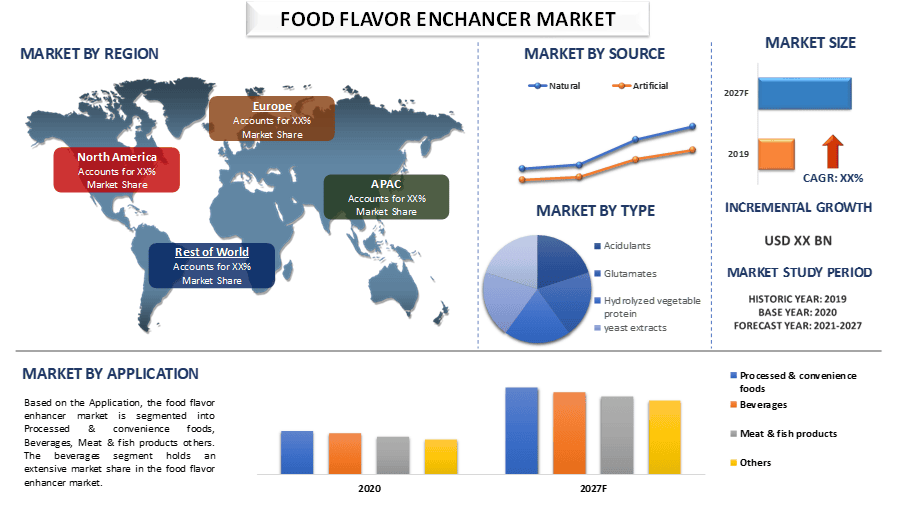
The Global Food flavor enhancer market is expected to grow at a CAGR of more than 5% during the forecast period (2021-2027). The food flavor enhancer market is growing at a propelling rate and is expected to have a substantial market demand in the forecasted period as well. Flavor enhancers are preservative that is added to the food to alter or improve the existing flavor. They are majorly added to food and beverages to enhance their taste and texture. It is commercially available in the form of snack foods, instant soups, frozen dinners, etc. Factors such as growing sensory-oriented consumers, modernized food habits, and increasing consumption of Monosodium Glutamate (MSG) in food products have been driving the global flavor enhancers market.
In addition, expanding demand for different and organic flavors in frozen food has grown demand for flavor enhancers in the market. Furthermore, the constantly changing quality and regulatory standards concerning the ensuring and safeguarding of consumer health and safety are posing a challenge to flavor producers in recent years.
Food flavor enhancers are substances that have no pronounced flavor or taste of their own, but which bring out and improve the flavors in the foods to which they are added. Flavorings can play an important nutritional role, particularly in foods that are not very flavorful, by providing the needed appeal. The most used substances in this category are monosodium L-glutamate (MSG), disodium 5′-inosinate (IMP), and disodium 5′- guanylate (GMP). Salt, although not classed as a food additive, is the most widely used flavor enhancer. Factors such as changing lifestyle, increasing demand for healthy ingredients, and influential trends for new exotic and ethnic flavors are driving the food flavor enhancers market. With the rising preference for premium-quality products, including premium lines of seasonings and sauces, the market is growing rapidly across the globe.
Food Flavor Enhancer, Type 2020
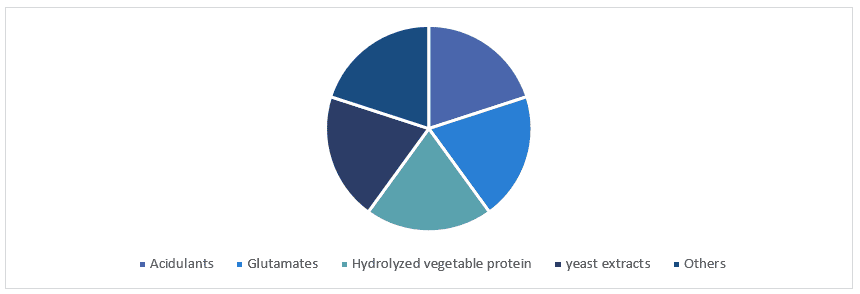
Cargill, Inc., Tate & Lyle Plc, Associated British Foods Plc, Corbion N.V., Sensient Technologies Corporation, International Flavors & Fragrances Inc., Firmenich Sa, Senomyx, Inc., Synergy Flavors, Mane SA. Several M&As along with partnerships have been undertaken by these players to facilitate customers with hi-tech and innovative products/technologies.
Insights Presented in the Report
“Amongst type, glutamates segment holds the major share”
Based on type, the food flavor enhancer market is segmented into acidulants, glutamates, hydrolyzed vegetable protein, yeast extracts and others. The glutamates catered to significant demand in the food flavor enhancer market. Glutamate is an amino acid that is produced in the body and occurs naturally in many foods. Monosodium glutamate (MSG) is the sodium salt of glutamic acid and is a common food additive. Both natural glutamate and monosodium glutamate are metabolized in the body using the same processes.
“Amongst source, natural segment holds the major share”
Based on the source, the food flavor enhancer market is bifurcated into artificial and natural. The natural segment holds a considerable market share in the food flavor enhancer market. Natural flavors comprise extracts from natural sources in the form of essential oils, oleoresins, essence or extractive, distillate, or products formed during processing such as roasting, heating, etc. Example of natural flavor is roasted coffee beans, extracts of vanilla roots, etc. Fruit flavor concentrate is a special type of natural flavor that is prepared by removing the water under vacuum and adding back aroma back into the concentrate.
“Amongst application, beverages segment holds the major share”
Based on the Application, the food flavor enhancer market is segmented into Processed & convenience foods, Beverages, Meat & fish products others. The beverages segment holds an extensive market share in the food flavor enhancer market. More consumption of beverages that are high in nutrients, support the immune system and improve the digestive functions of the body should further raise the product demand from the beverage industry. Rise usage of modern techniques such as ingrained technology for producing flavors to reduce the overall production time is expected to further foster the market growth during the assessment period.
“Asia Pacific represents one of the extensive market shares of global food flavor enhancer Market”
For a better understanding of the market dynamics of the global food flavor enhancer Asia Pacific caters substantial share in the food flavor enhancer market over the past few years and is expected to have an influential growth rate in the forecasted period as well. The surge in disposable income coupled with packaged sauces, ready-to-cook, and instant meals are gaining popularity in the region that has positively influenced the market size of the food flavor enhancer.
Reasons to buy this report:
- The study includes market sizing and forecasting analysis validated by authenticated key industry experts.
- The report presents a quick review of overall industry performance at one glance.
- The report covers an in-depth analysis of prominent industry peers with a primary focus on key business financials, product portfolios, expansion strategies, and recent developments.
- Detailed examination of drivers, restraints, key trends, and opportunities prevailing in the industry.
- The study comprehensively covers the market across different segments.
- Deep dive regional level analysis of the industry.
Customization Options:
The Global Food flavor enhancer market can further be customized as per the requirement or any other market segment. Besides this, UMI understands that you may have your own business needs, hence feel free to connect with us to get a report that completely suits your requirements.
Table of Contents
Analyzing the historical market, estimation of the current market, and forecasting the future market of the global food flavor enhancer market were the three major steps undertaken to create and analyze the adoption of food flavor enhancers in major regions globally. Exhaustive secondary research was conducted to collect the historical market numbers and estimate the current market size. Secondly, to validate these insights, numerous findings and assumptions were taken into consideration. Moreover, exhaustive primary interviews were also conducted, with industry experts across the value chain of the global food flavor enhancer market. Post assumption and validation of market numbers through primary interviews, we employed a top-down/bottom-up approach to forecasting the complete market size. Thereafter, market breakdown and data triangulation methods were adopted to estimate and analyze the market size of segments and sub-segments the industry pertains to. Detailed methodology is explained below:
Seek More Details About Research Methodology
Analysis of Historical Market Size
Step 1: In-Depth Study of Secondary Sources:
Detail secondary study was conducted to obtain the historical market size of the food flavor enhancer market through company internal sources such as annual reports & financial statements, performance presentations, press releases, etc., and external sources including journals, news & articles, government publications, competitor publications, sector reports, third-party database, and other credible publications.
Step 2: Market Segmentation:
After obtaining the historical market size of the food flavor enhancer market, we conducted a detailed secondary analysis to gather historical market insights and share for different segments & sub-segments for major regions. Major segments included in the report as type, source, form, and application. Further country-level analyses were conducted to evaluate the overall adoption of testing models in that region.
Step 3: Factor Analysis:
After acquiring the historical market size of different segments and sub-segments, we conducted a detailed factor analysis to estimate the current market size of the food flavor enhancer market. Further, we conducted factor analysis using dependent and independent variables such as expanding demand for different and organic flavors in frozen food surging adoption of the food flavor enhancer. A thorough analysis was conducted for demand and supply-side scenarios considering top partnerships, merger and acquisition, business expansion, and product launches in the Food flavor enhancer market sector across the globe.
Current Market Size Estimate & Forecast
Current Market Sizing: Based on actionable insights from the above 3 steps, we arrived at the current market size, key players in the global food flavor enhancer market, and market shares of the segments. All the required percentage shares split, and market breakdowns were determined using the above-mentioned secondary approach and were verified through primary interviews.
Estimation & Forecasting: For market estimation and forecast, weights were assigned to different factors including drivers & trends, restraints, and opportunities available for the stakeholders. After analyzing these factors, relevant forecasting techniques i.e., top-down/bottom-up approach were applied to arrive at the market forecast about 2027 for different segments and sub-segments across the major markets globally. The research methodology adopted to estimate the market size encompasses:
- The industry’s market size, in terms of value (US$) and the adoption rate of food flavor enhancer market across the major markets domestically
- All percentage shares, splits, and breakdowns of market segments and sub-segments
- Key players in the global food flavor enhancer market in terms of the category offered. Also, the growth strategies adopted by these players to compete in the fast-growing market
Market Size and Share Validation
Primary Research: In-depth interviews were conducted with the Key Opinion Leaders (KOLs) including Top Level Executives (CXO/VPs, Sales Head, Marketing Head, Operational Head, and Regional Head, Country Head, etc.) across major regions. Primary research findings were then summarized, and statistical analysis was performed to prove the stated hypothesis. Inputs from primary research were consolidated with secondary findings, hence turning information into actionable insights.
Split of Primary Participants in Different Regions
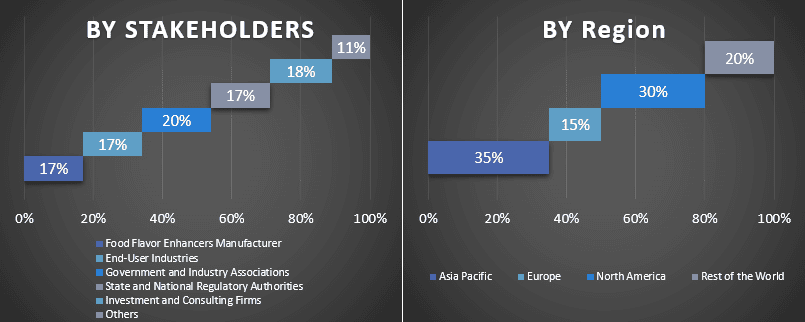
Market Engineering
Data triangulation technique was employed to complete the overall market estimation and to arrive at precise statistical numbers of each segment and sub-segment of the global food flavor enhancer market. Data was split into several segments & sub-segments post studying various parameters and trends in the areas of type, source, form, and application in the global food flavor enhancer market.
The main objective of the Global Food Flavor Enhancer Market Study
The current & future market trends of the global food flavor enhancer market were pinpointed in the study. Investors can gain strategic insights to base their discretion for investments from the qualitative and quantitative analysis performed in the study. Current and future market trends were determined the overall attractiveness of the market at a regional level, providing a platform for the industrial participant to exploit the untapped market to benefit as a first-mover advantage. Other quantitative goals of the studies include:
- Analyze the current and forecast market size of the food flavor enhancer market in terms of value (US$). Also, analyze the current and forecast market size of different segments and sub-segments
- Segments in the study include areas of type, source, form, and application.
- Define and analysis of the regulatory framework for the food flavor enhancer market industry.
- Analyze the value chain involved with the presence of various intermediaries, along with analyzing customer and competitor behaviors of the industry.
- Analyze the current and forecast market size of the food flavor enhancer market for the major region.
- Major regions studied in the report include Asia Pacific, Europe, North America, and the Rest of the World.
- Company profiles of the food flavor enhancer market and the growth strategies adopted by the market players to sustain in the fast-growing market
- Deep dive regional level analysis of the industry
Related Reports
Customers who bought this item also bought

